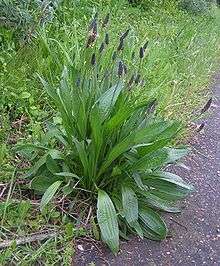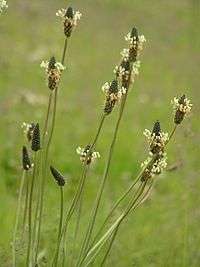Plantago lanceolata
| Ribwort plantain | |
|---|---|
 | |
| Scientific classification | |
| Kingdom: | Plantae |
| (unranked): | Angiosperms |
| (unranked): | Eudicots |
| (unranked): | Asterids |
| Order: | Lamiales |
| Family: | Plantaginaceae |
| Genus: | Plantago |
| Species: | P. lanceolata |
| Binomial name | |
| Plantago lanceolata L. | |
Plantago lanceolata is a species of flowering plant in the plantain family Plantaginaceae. It is known by the common names English plantain, narrowleaf plantain, ribwort plantain,[1] ribleaf and lamb's tongue. It is a common weed of cultivated land.
Description
The plant is a rosette-forming perennial herb, with leafless, silky, hairy flower stems (10–40 cm or 3.9–15.7 in). The basal leaves are lanceolate spreading or erect, scarcely toothed with 3-5 strong parallel veins narrowed to short petiole. Grouping leaf stalk deeply furrowed, ending in an ovoid inflorescence of many small flowers each with a pointed bract. Each flower can produce up to two seeds. Flowers 4 mm (calyx green, corolla brownish), 4 bent back lobes with brown midribs, long white stamens. Found in British Isles, scarce on acidic soils (pH < 4.5). It is considered an invasive weed in North America. It is present and widespread in the Americas and Australia as an introduced species.
Distribution
Plantago lanceolata is native to Eurasia, but has been introduced to North America and many other parts of the world with suitable habitats.[2]
History

Considered to be an indicator of agriculture in pollen diagrams, P. lanceolata has been found in western Norway from the Early Neolithic onwards, something considered an indicator of grazing in that area.[3]
Uses
P. lanceolata is used frequently in herbal teas and other herbal remedies.[4] A tea from the leaves is used as a highly effective cough medicine. In the traditional Austrian medicine Plantago lanceolata leaves have been used internally (as syrup or tea) or externally (fresh leaves) for treatment of disorders of the respiratory tract, skin, insect bites, and infections.[5]
Chemistry
P. lanceolata contains phenylethanoids such as acteoside (verbascoside), cistanoside F, lavandulifolioside, plantamajoside and isoacteoside.[6] It also contains the iridoid glycosides aucubin and catalpol.[7]
Habitat
Plantago lanceolata, can live anywhere from very dry meadows to places similar to a rain forest.[8]
Reproduction
The mode of reproduction can vary among populations of P. lanceolata.[9] Reproduction can either occur asexually via cloning or sexually, with the pollen being wind dispersed.[9] In the populations that reproduce asexually via cloning, genetic variation is much lower than the populations that reproduce sexually.[8]
Infection by powdery mildew
Podosphaera plantaginis is a powdery mildew fungus that infects P. lanceolata. All of the P. lanceolata populations are infected by several strains of this powdery mildew fungus.[10] Once the populations are infected, the symptoms are minimal at first. Then, after a few months lesions start to appear covering the entire surface of the leaves and the stem, making it very noticeable.[8]
Resistance to powdery mildew
After the populations are infected, they react in different ways. Some populations of P. lanceolata are more susceptible to different strains of powdery mildew. Also, some populations have multiple resistance phenotypes where on the other hand, others may only have one resistance phenotype.[8] Overall, the populations that have the highest variety of resistance phenotypes will have the highest survival rates particularly when rates of infection are high.[8]
References
- ↑ "BSBI List 2007". Botanical Society of Britain and Ireland. Archived from the original (xls) on 2015-02-25. Retrieved 2014-10-17.
- ↑ Anderberg, Arne. "Den Virtuella Floran, Pinguicula vulgaris L.". Naturhistoriska riksmuseet, Stockholm, Sweden.
- ↑ Hjelle, K. L.; Hufthammer, A. K.; Bergsvik, K. A. (2006). "Hesitant hunters: a review of the introduction of agriculture in western Norway". Environmental Archaeology. 11 (2): 147–170. doi:10.1179/174963106x123188.
- ↑ Val plantes herbal ice tea
- ↑ Vogl S, Picker P, Mihaly-Bison J, et al. (October 2013). "Ethnopharmacological in vitro studies on Austria's folk medicine--an unexplored lore in vitro anti-inflammatory activities of 71 Austrian traditional herbal drugs". Journal of Ethnopharmacology. 149 (3): 750–71. doi:10.1016/j.jep.2013.06.007. PMC 3791396
 . PMID 23770053.
. PMID 23770053. - ↑ Phenylethanoids in the Herb of Plantago lanceolata and Inhibitory Effect on Arachidonic Acid-Induced Mouse Ear Edema. Michiko Murai (nee Sasahara), Yasuhiko Tamayama and Sansei Nishibe, Planta Med., 1995;, volume 61, issue 5, pages 479-480, doi:10.1055/s-2006-958143
- ↑ Genetic variation in defensive chemistry in Plantago lanceolata (Plantaginaceae) and its effect on the specialist herbivore Junonia coenia (Nymphalidae). Lynn S. Adler, Johanna Schmitt and M. Deane Bowers, Oecologia, January 1995, Volume 101, Issue 1, pages 75-85, doi:10.1007/BF00328903
- 1 2 3 4 5 Laiine, Anna Lisa. 2005. Journal of Evolutionary Biology. Journal of Evolutionary Biology. 18, 930-938.
- 1 2 Jousimo, Jussi. 2014. Ecological and evolutionary effects of fragmentation on infectious disease dynamics. Science AAAS Journal. Science 344, 1289-1293.
- ↑ Laiine, Anna Lisa. 2004. Resistance variation within and among host populations in a plant- pathogen metapopulation: implications for regional pathogen dynamics. Journal of Ecology 92, 990-1000.
External links
| Wikimedia Commons has media related to Plantago lanceolata. |
| Wikispecies has information related to: Plantago lanceolata |
| Wikiversity has bloom time data for Plantago lanceolata on the Bloom Clock |